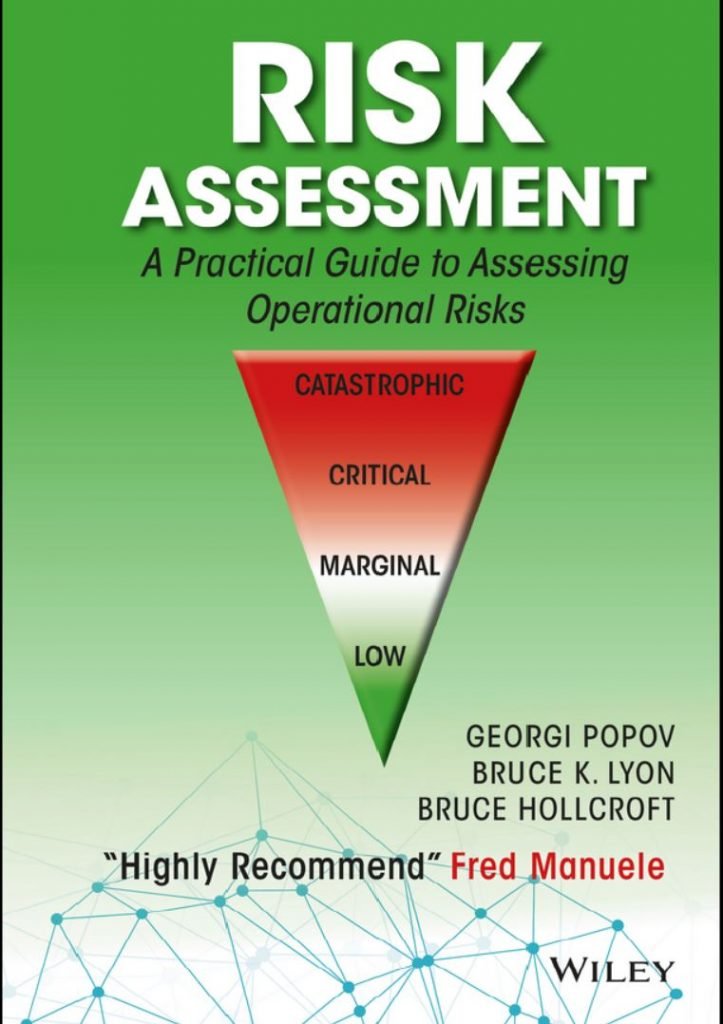E-Books: Risk Assessment A Practical Guide to Assessing Operational Risks
6 min readRisk Assessment A Practical Guide to Assessing Operational Risks by Bruce Hollcroft, Bruce K. Lyon, and Georgi Popov. The book provides the fundamentals of risk assessment, with many practical applications, for undergraduate and graduate students and employed safety, health, and environmental professionals who recognize that they are expected to have risk assessment capabilities. This text serves the needs of professors at a university level who recognize that their students have knowledge and capability with respect to risk assessment while addressing seven of the Accreditation Board for Engineering and Technology (ABET) criteria for safety programs. In addition, the book serves as a primer for employed safety professionals who need a practical guide on various risk assessment techniques.
BIGGEST ORGANIZATIONAL RISK!
The information and tools contained in “Risk Assessment: A Practical Guide to Assessing Operational Risks” should get into the hands and minds of every practicing environmental, health, and safety (EH&S) professional. The biggest risk to an organization is not taking a risk-based approach.to protecting people, property, and the environment.
“WHAT-IF”
“What-If” the EH&S community, business leaders, and workers adopted and practiced a risk-centric approach to their work and decision-making? “What-If” a tangible face could be put on “safe work” by seeing and acting on the risk in advance of mishaps? The authors have made the business case and provided us with a road map and resources to enable these two possibilities to become a reality.
“NEW VIEW” OF SAFETY


The authors outline and take us away from the “old view” of safety (the double negative – absence, and harm) to the “new view” of safety (the double-positive – presence and well-being). Organizational confidence in assessing operational risks will come when adopting and building upon the principles and learnings that come from this author’s body of work. Defining what “safe” looks like must become the future of our profession.
THE VOICE OF THE WORKER
It is my personal belief that if the 50,000+workers who have died on the job over the past decade could have a collective voice today, they would clearly tell us to seek out the risk in work and processes and act on them in advance of sustaining life-ending or life-altering events. It is all about the risk!
JUST DO IT!
It is my desire and wish every EH&S professional take on a risk-based approach in their work and job role and enroll others in the process as well. Those who adopt the thinking and approach found in “Risk Assessment: A Practical Guide to Assessing Operational Risks” will enjoy a rewarding and productive career as well as leave a lasting legacy where new designs, job tasks, and process risks are free from unacceptable risk.


Throughout the world, there has been a proliferation of activity resulting in provisions being included in safety standards, guidelines, and operational risk management systems requiring or promoting that risk assessments be made. This trend has had an impact on the knowledge and skills that safety professionals are required to have in their employment. It will also provide career enhancement opportunities and job satisfaction for them.
Working with design and operations personnel to assess risks and to give counsel in the decision-making to achieve acceptable risk levels adds an easily recognized value. Imaginative safety professionals will recognize this opportunity to be additionally perceived as members of the management team and increase their value to their organizations.
An addendum for this chapter consists of a list of standards, guidelines, and initiatives that require or promote making risk assessments. To avoid having the list become overly lengthy, 2005 was selected as the year to commence recordings. Although data is included for 35 subjects, it is more
than likely the list is not complete.
To provide guidance for safety professionals on the trending throughout the world on requirements for risk assessments and recognition of the need for safety professionals to have risk assessment capability, this chapter will comment on the following:
- Activities initiated by the American Society of Safety Engineers (ASSE)
- A guideline that gives risk assessment high priority within an operational risk management system
- Selected standards and guidelines to demonstrate
- The pace and import of recent activity;
- The variations in content for risk assessments in the standards and guidelines;
- Specificity or, lack thereof, in their content.
There are similarities and differences in the approaches taken by the drafters of these standards and guidelines. Some are industry-specific. Others apply across all industries. The message they give is clear: Safety professionals will be expected to have knowledge of a variety of hazard analysis and risk assessment methods and how to apply them.
Contents
The Contents of A Practical Guide to Assessing Operational Risks
- Risk Assessments: Their Significance and the Role of the Safety Professional
- Risk Assessment Standards and Definitions
- Risk Assessment Fundamentals
- Defining Risk Assessment Criteria
- Introduction to international health and safety at work
- Fundamental Techniques
- What-If Hazard Analysis
- Preliminary Hazard Analysis
- Failure Mode and Effects Analysis
- Bow-Tie Risk Assessment Methodology
- Design Safety Reviews
- Hazop guide to best practice third edition
- Risk Assessment and the Prevention Through Design (PtD) Model
- Industrial Hygiene Risk Assessment
- Machine Risk Assessments
- Project-Oriented Risk Assessments
- Food Processing Risk Assessments
- Ergonomic Risk Assessment
- Assessing Operational Risks at an Organizational Level
- Business Aspects of Operational Risk Assessment
- Risk Assessment: Global Perspectives
Download the book
Risk Assessment a practical Guide to Assessing Operational Risks
More Downloads
- E-Books: Healthcare Hazard Control & Safety Management
- E-Books: Safety, Health and Working Conditions Training Manual
- E-Books: Energy Efficiency in Water and Wastewater Facilities
- E-Books: Fire Service Features of Buildings and Fire Protection Systems
- E-Books: Evaluation of Fire Safety free download
- E-Books: PPE for Chemical, Biological, and Radiological Hazards free
- E-Books: Changing the Workplace Safety Culture free download
- E-Books: Site Emergency Planning Workbook
- E-Books: Load Restraint Guide
- E-Books: Essential Practices for Creating, Strengthening, and Sustaining Process Safety Culture
- E-Books: System Safety Engineering and Risk Assessment
- E-Books: Permit-Required Confined Spaces
- E-Books: Is it Safe to Enter Confined Space?
- E-Books: 5-Minute Workplace Safety Talks
- E-Books: Safety Culture and High-Risk Environments
- E-Books: Practical Guide to Industrial Safety
- E-Books: Slip, Trip, and Fall Prevention for Healthcare Workers
- E-Books: Health and Safety at Work Key Terms
- E-Books: Fundamentals of Process Safety Engineering
- E-Books: Gas Detection Hand Book
- E-Books: Occupational health and safety management systems ANSI-AIHA-z10-2012
- E-Books: Hot Work on Drums and Tanks
- E-Books: Human Fatigue Risk Management
- E-Books: Guidelines for the provision of facilities and general safety in the construction industry
- E-Books: Handbook of Training in Mine Rescue and Recovery Operations ( 2021)
- E-Books: Code of Practice for the Safe Use of Lifting Equipment – Edition 9 (Nov 2019)
- E-Books: Free Forklift Health and Safety Best Practices Guideline
- E-Books: Handbook of Hazardous Chemical Properties
- E-Books: Human Performance Improvement through Human Error Prevention
- E-Books: Principles Of Fire Risk Assessment In Buildings
- E-Books: Investigation of Occupational Accidents and Diseases
- E-Books: Radiation Protection and Safety in Industrial Radiography
- E-Books: Basic Guide to System Safety, Third Edition
- E-Books: Food Safety Management-A Practical Guide for the Food Industry
- E-Books: Safety identification: Escape and evacuation plan signs- ISO 23601
- E-Books: Safety at Work
- E-Books: The Safety-Critical Systems Handbook 4th edition
- E-Books: Fundamental principles of occupational health and safety
- E-Books: Fire Safety Risk assessment Guide – Sleeping Accommodation
- E-Books: Mental health at work series
- E-Books: Live Fire Training: Principles and Practice
- E-Books: Pre-Startup Safety Review Guide
- E-Books: Fire and Emergency Drill Manual and Building Inspection Guide
- E-Books: Health and Safety: Risk Management 5th edition
- E-Books: Fire Protection systems -Third edition 2021
- E-Books: Fire Safety Logbook templates
- E-Books: From Accidents to Zero
- E-Books: Electric Safety Practice and Standards
- Your steps to chemical safety
- E-Books: Ergonomics and Psychology Developments in Theory and Practice
- E-Books: HAZOPS Should BE fun-The Stream-Based HAZOP
- E-Books: Safety Health and Environmental Auditing
- E-Books: A Quick Guide to Health and Safety
- E-Books: Occupational Ergonomics A Practical Approach
- E-Books: Job Hazard Analysis A Guide for Voluntary Compliance and Beyond
- E-Books: Electrical Safety of Low Voltage Systems




2 thoughts on “E-Books: Risk Assessment A Practical Guide to Assessing Operational Risks”